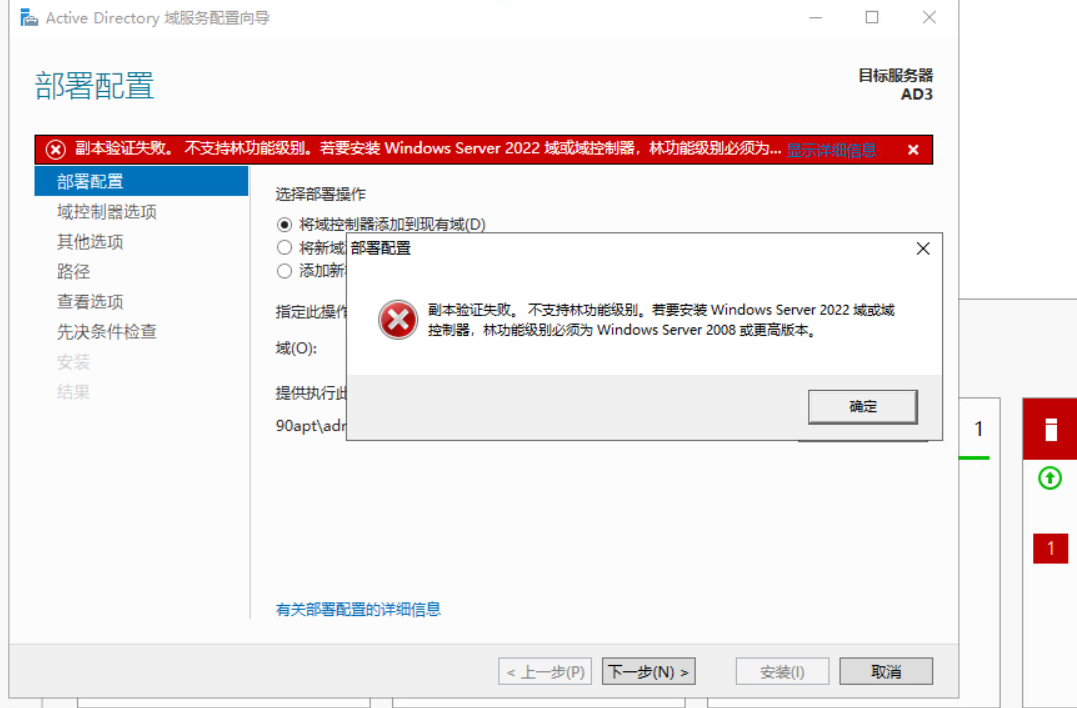mysql group by 实战
实际操作命令演示:select+from+where+group by+聚合函数(统计函数) 结合使用情况
在利用select语句查询数据信息,结合group by子句可以实现分组查询,并且还必须配合聚合函数对分组查询的数据做相应处理;
数据库服务中常用的聚合函数(统计函数):
| 序号 | 函数信息 | 解释说明 | |----|----------------|--------------------------------| | 01 | count() | 表示求指定列的总记录数 | | 02 | sum() | 此函数表示求指定列的和 | | 03 | avg() | 此函数表示对数值信息进行求平均值 | | 04 | min() | 此函数表示对数值信息进行取最小值 | | 05 | max() | 此函数表示对数值信息进行取最大值 | | 06 | group_concat() | 此函数表示输出信息无法匹配分组和聚合函数时,进行拼接整合显示 |
利用group by进行分组查询的执行逻辑分析:
- 根据查询语句信息,取出表中关注的列字段信息;
- 根据查询分组信息,将特定列字段信息进行排序,从而将分组的一致信息整合在一起(形成结果集);
- 根据分组合并信息,结合使用的聚合函数,进行数值信息运算或统计(生成最终结果);
- 根据分组聚合要求,分组信息输出时必须和分组信息一一对应,但特殊列无法一一对应输出时,可使用group_concat()拼接输出
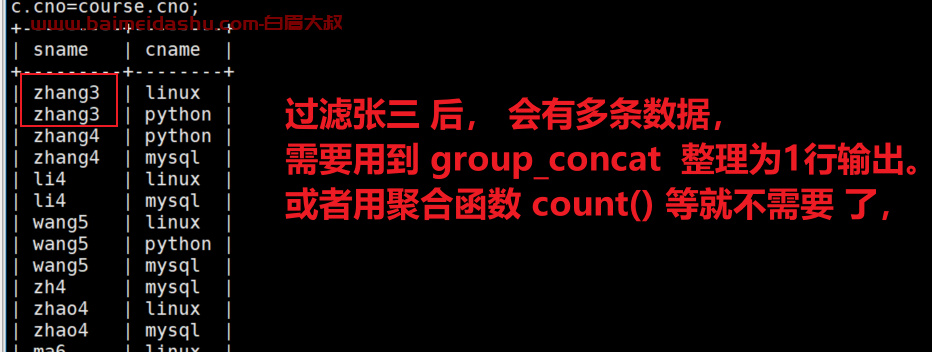
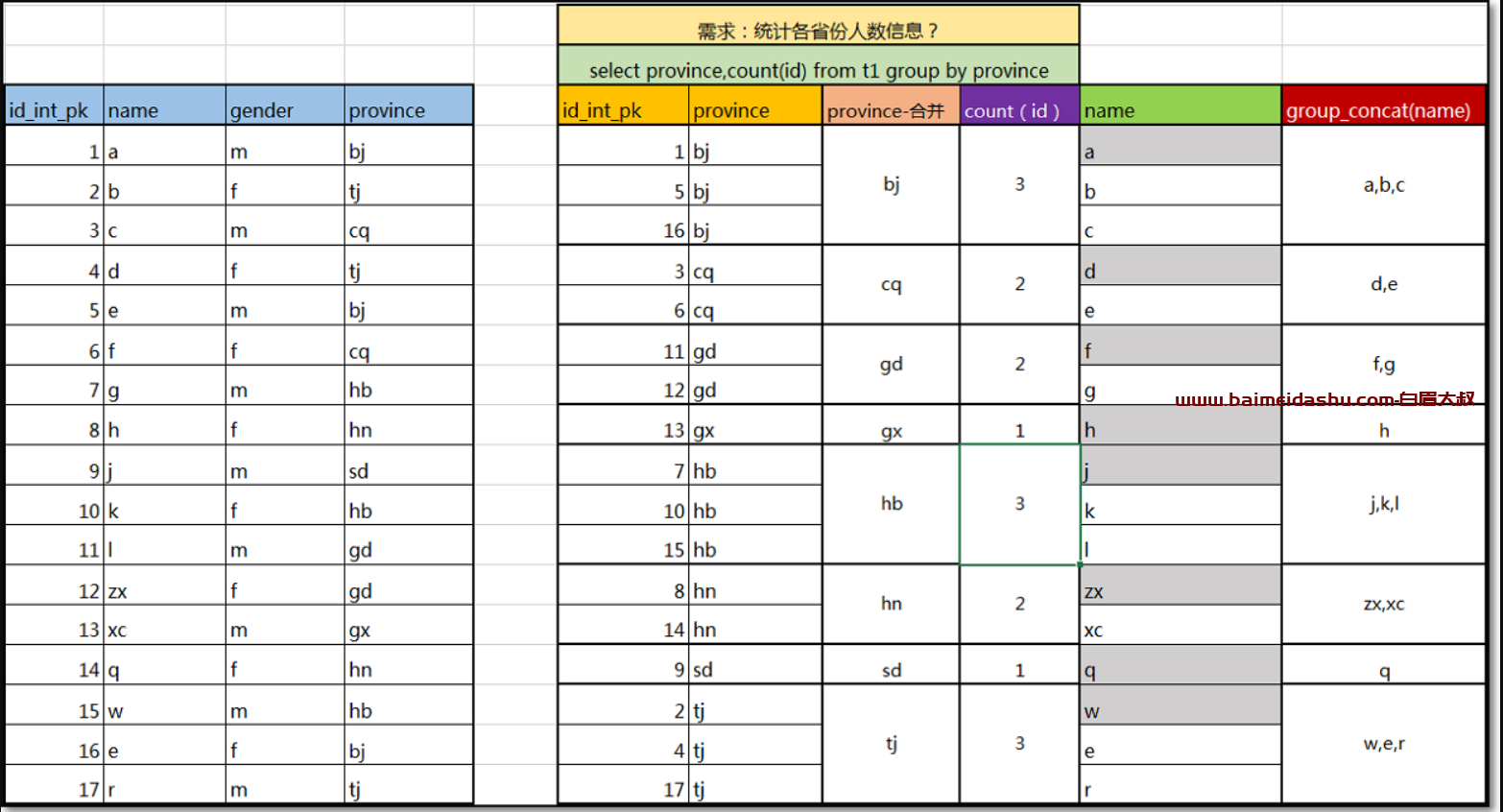
测试 ,导入数据 :
数据在这里
mysql: https://url69.ctfile.com/d/253469-56755836-403176?p=2206 (访问密码: 2206)
/usr/local/mysql/bin/mysql -uroot -p123456 < world.sql

实际操作命令演示:获取分组数据信息进行聚合函数处理实践:
# 查询统计每个国家的人口总数
我们先看看表结构

首先
查询统计每个国家的人口总数
select * from world.city goupby CountryCode ; #现根据 国家分组
#然后早出 人口总数
select CountryCode, sum(population) from world.city group by CountryCode;
-- 根据国家信息分组聚合,在将分组后所有城市的人口数量进行sum求和运算,实现国家信息对应人口总数的1对1关系
查询统计每个省份的城市个数
# 查询统计每个省份的城市个数
select district , count(district) from city group by district ;
中国的代码为 chn
select district , count(district) from city where countrycode='chn' group by district ;
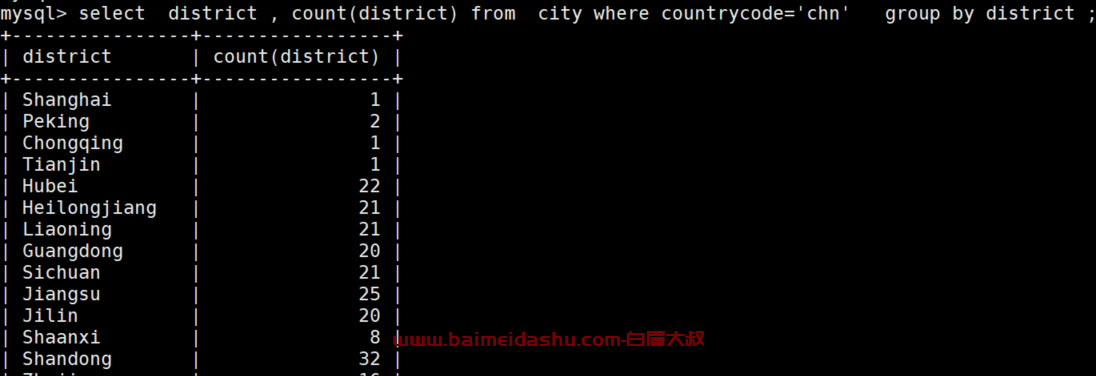
# 查询统计每个省份的城市个数,以及城市名称信息(经常面试题考到)
select district , count(district),name from city where countrycode='chn' group by district ;
会出现报错

-- 由于数据库sql_mode配置了only_full_group_by,由于输出的name信息不能和district信息实现1对1关系,因此报错
解决方案:
-- 利用group_concat()就可以实现没有出现在分组和聚合函数中的字段,采取拼接整合方式显示,满足分组1对1关系
select district , count(district),group_concat(name) from city where countrycode='chn' group by district ;

实际操作命令演示:select+from+where+group by+聚合函数+having
在利用select语句查询数据信息,结合分组和聚合函数处理之后,可以将输出的信息再进行过滤处理(having);
having是在分组后对数据进行过滤.,where是在分组前对数据进行过滤。
实际操作命令演示:对分组聚合后数据进行过滤处理
# 查询统计每个国家的人口总数,只显示人口数量超过1个亿的信息
select sum(population) from city group by CountryCode having sum(population) > 100000000;

实际操作命令演示:select+from+where+group by+聚合函数+having+order by
在利用select语句查询数据信息,结合分组和聚合函数处理之后,并且再次经过筛选的数据,按照一定数值规律排序显示信息
实际操作命令演示:
# 查询统计每个国家的人口总数,只显示人口数量超过5千万的信息,并且按照国家人口总数排序显示
select countrycode, sum(population) from city group by CountryCode having sum(population) > 50000000 order by sum(population);
-- 实现了人口数量从小到大排序(升序/正序)
select countrycode, sum(population) from city group by CountryCode having sum(population) > 50000000 order by sum(population) desc;
-- 实现了人口数量从大到小排序(降序/逆序)
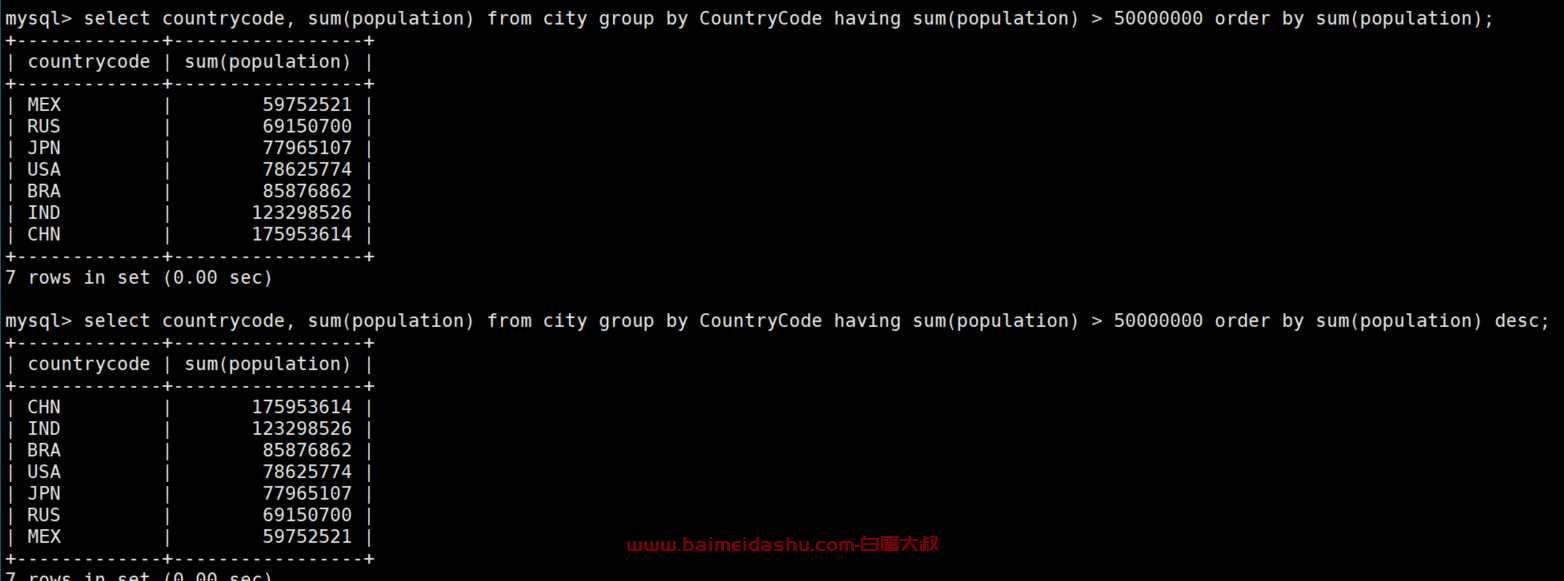
实际操作命令演示:select+from+where+group by+聚合函数+having+order by+limit
在利用select语句查询数据信息,结合分组和聚合函数处理之后经过筛选的数据,按照一定数值规律排序显示信息,并限制输出内容行数
实际操作命令演示:
# 查询统计每个国家的人口总数,只显示人口数量超过5千万的信息,并且按照国家人口总数从大到小排序,只显示前三名
mysql > select countrycode,sum(population) from world.city group by countrycode having sum(population)>50000000 order by sum(population) desc limit 3;
或者
mysql > select countrycode,sum(population) from world.city group by countrycode having sum(population)>50000000 order by sum(population) desc limit 0,3;
mysql > select countrycode,sum(population) from world.city group by countrycode having sum(population)>50000000 order by sum(population) desc limit 3 offset 0;
# 查询统计每个国家的人口总数,只显示人口数量超过5千万的信息,并且按照国家人口总数从大到小排序,只显示三~五名
mysql > select countrycode,sum(population) from world.city group by countrycode having sum(population)>50000000 order by sum(population) desc limit 2,3;
或者
mysql > select countrycode,sum(population) from world.city group by countrycode having sum(population)>50000000 order by sum(population) desc limit 3 offset 2;
-- 跳过前2名,显示后面的三名数据信息
 51工具盒子
51工具盒子




